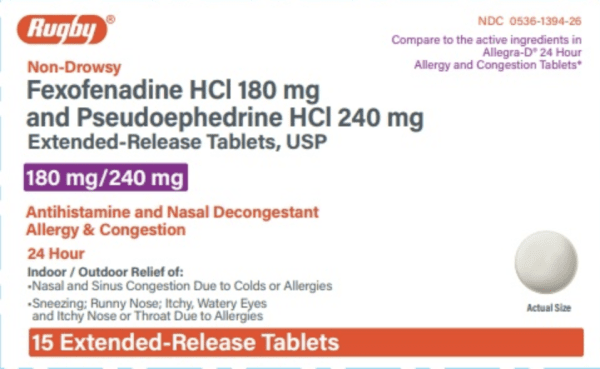Fexofenadine/pseudoephedrine Interactions
There are 331 drugs known to interact with fexofenadine/pseudoephedrine, along with 7 disease interactions, and 2 alcohol/food interactions. Of the total drug interactions, 21 are major, 292 are moderate, and 18 are minor.
- View all 331 medications that may interact with fexofenadine/pseudoephedrine
- View fexofenadine/pseudoephedrine alcohol/food interactions (2)
- View fexofenadine/pseudoephedrine disease interactions (7)
Most frequently checked interactions
View interaction reports for fexofenadine / pseudoephedrine and the medicines listed below.
- Adderall (amphetamine / dextroamphetamine)
- Aspirin Low Strength (aspirin)
- Augmentin (amoxicillin / clavulanate)
- Azithromycin Dose Pack (azithromycin)
- Benadryl (diphenhydramine)
- Celebrex (celecoxib)
- Cymbalta (duloxetine)
- Fish Oil (omega-3 polyunsaturated fatty acids)
- Lamictal (lamotrigine)
- Lexapro (escitalopram)
- Lipitor (atorvastatin)
- Lyrica (pregabalin)
- MiraLAX (polyethylene glycol 3350)
- Nasonex (mometasone nasal)
- Nexium (esomeprazole)
- Norco (acetaminophen / hydrocodone)
- Paracetamol (acetaminophen)
- ProAir HFA (albuterol)
- Singulair (montelukast)
- Symbicort (budesonide / formoterol)
- Tylenol (acetaminophen)
- Vitamin B12 (cyanocobalamin)
- Vitamin C (ascorbic acid)
- Vitamin D2 (ergocalciferol)
- Vitamin D3 (cholecalciferol)
- Wellbutrin (bupropion)
- Wellbutrin XL (bupropion)
- Zofran (ondansetron)
- Zoloft (sertraline)
- Zyrtec (cetirizine)
Fexofenadine/pseudoephedrine alcohol/food interactions
There are 2 alcohol/food interactions with fexofenadine / pseudoephedrine.
Fexofenadine/pseudoephedrine disease interactions
There are 7 disease interactions with fexofenadine / pseudoephedrine which include:
More about fexofenadine / pseudoephedrine
- fexofenadine/pseudoephedrine consumer information
- Compare alternatives
- Pricing & coupons
- Reviews (64)
- Drug images
- Side effects
- Dosage information
- During pregnancy
- Drug class: upper respiratory combinations
Related treatment guides
Drug Interaction Classification
| Highly clinically significant. Avoid combinations; the risk of the interaction outweighs the benefit. | |
| Moderately clinically significant. Usually avoid combinations; use it only under special circumstances. | |
| Minimally clinically significant. Minimize risk; assess risk and consider an alternative drug, take steps to circumvent the interaction risk and/or institute a monitoring plan. | |
| No interaction information available. |
Further information
Always consult your healthcare provider to ensure the information displayed on this page applies to your personal circumstances.


